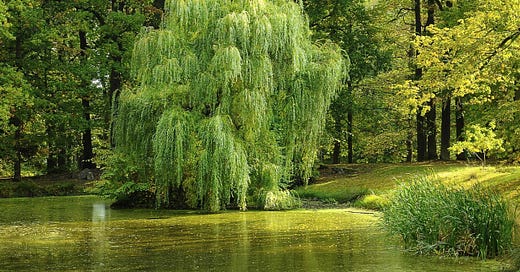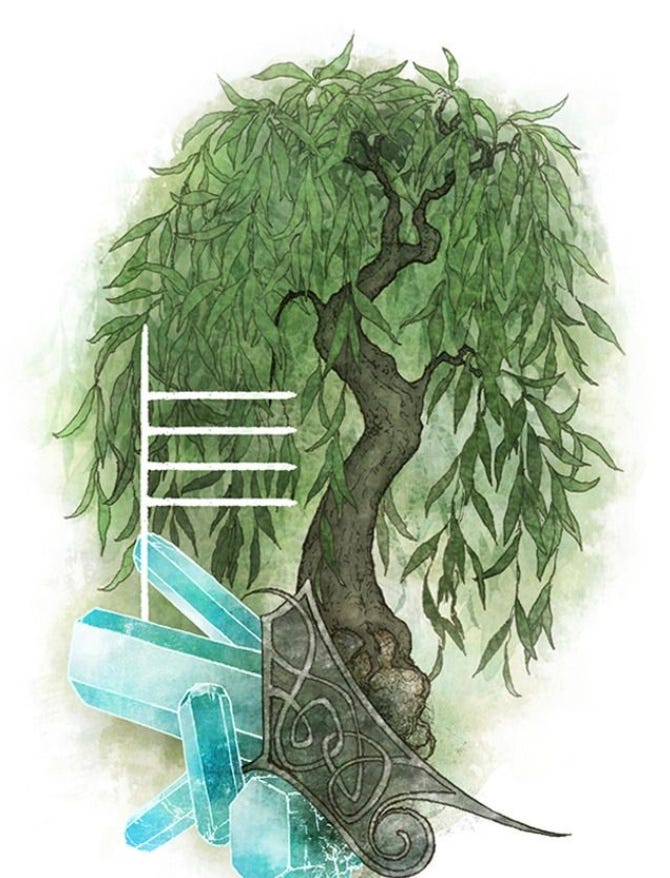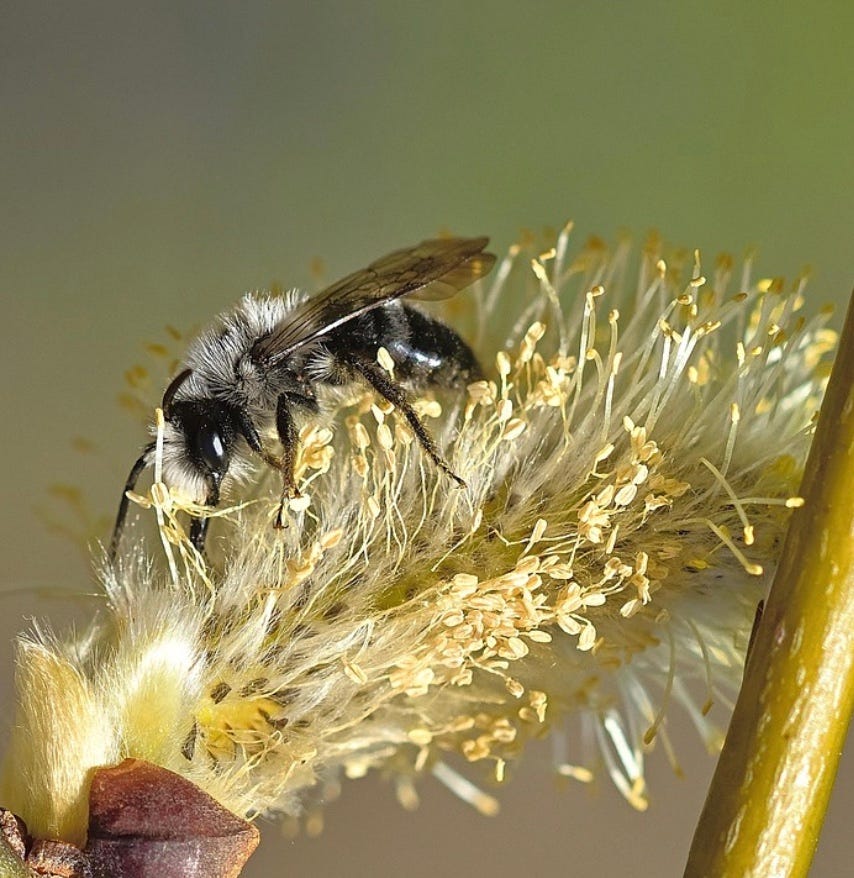Welcome everyone, and Happy Easter Sunday to you all. We continue with our monthly turn around the Celtic Tree calender and find ourselves arriving to late April and on this occasion to the Willow tree.
I must say I am appreciating this time to lay down my tools from a few busy weeks of yurt-making to come back to my Substack and this series on the Trees of Ireland. I hope you are enjoying it and learning as much as I am.
We begin with some reflections.
First Encounters
It was during my time studying permaculture and practical sustainability—one of those earthy, rain-spattered courses where your hands are always in the soil and your boots never quite dry. One afternoon, a willow basket-maker came to visit us, arriving from a strange-sounding place called Coole Mountain, somewhere out west. She carried with her not just bundles of withies—those long, slender rods of willow that she lay out on the classroom floor and segregated by colour—but an assortment of baskets and woven creations, and strings and secateurs, and a kind of reverence for this tree that I'd never encountered before. Willow was her life.
She showed us how to weave the rods into any object of our choice, starting with the age-old technique of crossing rods to form the first lattice—the foundational X from which all baskets, bowls, and forms are born. The movement was simple but precise: one rod twisted over the other, the fingers working hard, tension held in the fingertips, with just enough pressure to hold without snapping. With a half-serious intention, I decided to make a fedora hat. But my vision did not match my technical skill and eventually I fumbled to a kind of completion. What I created was something resembling a hat, sure—it perched on my head for a brief and uncomfortable moment, and was never worn again, being as it was, closer to a crown of thorns than a soft head piece.
I knew I wasn’t going to embrace willow weaving with any sustained interest since that first encounter, but since then willow in its own way has always been a compannion and a part of my life. Willow has continued to live in my mind as this multi-functional marvel—a tree that gifts us with these magical, pliable wands that can become almost anything: fences, arches, domes, cradles, coffins. On my travels and work throughout the festival culture of Ireland I’ve seen willow woven into life-sized horses, into foxes and mythological figures, tall standing woman and mythological beasts. Willow has become this bridge between craft and story, between nature and culture. For that alone it has always won my respect and admiration.
It’s a tree that has stepped quietly into my life. I’ve visited smallholdings where rows of willow stand alone in a damp reed covered field, their many-coloured stems glowing against the pale winter sky. It’s a beautiful sight, the sight of a plant in its favoured environment and thriving. From poor bogey land, they offer not only a harvest of surprising abundance — but also beauty.
A Tree of Water and Light
Once again we are in the company of a tree that is happy to have its feet wet. Willow is a water-loving tree, thriving along riverbanks, ditches, and the edges of boggy fields. Like alder, it occupies the margins, the in-between places. But where alder is stout, more tree-like you might say, willow is often a drooping yet graceful mass of thin branches, yielding to its own weight—moving with the wind, its thin spear-like leaves shimmering in sunlight.
It has a special knack for propagation. Simply press a rod into the ground, and if the soil is moist enough, it will take root. Its growth is exuberant, sometimes almost wild. I’ve heard told that one should never plant a willow close to a houses foundations for the roots are liable to grow into those foundations and cause damage. This vitality has made it a common sight throughout the countryside of Ireland.
Identifying the Willow Tree
There are several native willows in Ireland, but one of the most common is the goat willow (Salix caprea), sometimes called sallow. Its broad, slightly fuzzy leaves distinguish it from the more slender-leaved species, and its catkins—known as “pussy willows”—are among the first signs of spring. These soft, silvery tufts emerge even before the leaves.
Other willows, like white willow (Salix alba) and osier (Salix viminalis), are more familiar to basket-makers. These varieties grow tall and straight, with long, flexible rods perfect for weaving. And as mentioned before their bare stems can glow red, yellow, or gold, lighting up the landscape. This aspect has given willow a place in landscape gardening, creating that oft sought after ‘Winter interest.’
A Tree of Healing and the Moon
In the Celtic tradition trees were held in high esteem, they were not just a physical presence, they had a sacred element, and were seen as teachers for the human realm. In willows case it has long been associated with water, sorrow, and the moon. Many sacred sites, including wells and springs, feature willows, representing the union of earth and water. In Irish tradition, it was one of the féidhbheart—the seven noble trees. Its name in Irish, sail, is the origin of the Ogham character Saille, linked with intuition, healing, and the flow of emotion. It was believed to hold the gift of song and prophecy, and bards would sometimes craft their harps from willow wood to channel these gifts.
Its bark contains salicin, a natural pain-reliever that became the basis for modern aspirin. For this reason, willow was seen as a very practical ally—capable of soothing fever, pain, and inflammation. It was a tree of healing in the most direct sense. You can use the bark and the leaves to make an infusion or a tea to treat a variety of ailments. This was once a common practise when we didn’t have a local pharmacy to buy painkillers from.
At the same time, it carried a deeper symbolism. Because its branches bend without breaking, it became a symbol of resilience and sorrow. It appears often in songs of lament and longing, especially in English and Irish folk traditions, where a lover is said to wear a willow wreath when mourning loss.
Rooted in the In-Between
Willow grows where the land meets water, and so it occupies a threshold space—one foot in each world. These are the places where the veil is thinner, and there are stories telling of people finding entry to the Otherworld at the base of a willow tree.
Thus in older times, willow was often planted near wells and holy sites. It was said to be a portal tree. Witches’ brooms were made from its twigs. Cradles and coffins alike were crafted from its wood, marking both entrance and exit from this life. And today this tradition is coming alive again, speaking to our longing to be more deeply connected to the cycles of life.
The Future of Willow
In Ireland, the future of willow looks brighter than that of many native trees. Rewilding projects are rediscovering its usefulness, both as a pioneer species and as a stabiliser of flood-prone land. Craft traditions are returning, and with them a deeper respect for the land that supports them.
But like all trees, it needs space, water, and time. It thrives best in places allowed to be wild around the edges, where the soil is not drained, the rivers not straightened, the hedgerows not slashed. Often these are not the most accessible or attractive looking spaces, and so they are easily looked over, but for our ecology they are essential.
As one of the earliest trees to flower in spring, its catkins provide a crucial source of nectar and pollen for awakening bees and other pollinators emerging from winter dormancy. Its flexible branches and dense growth offer ideal nesting sites for birds, while its leaves feed the caterpillars of numerous moths and butterflies. There is a willow growing outside my home in Cork and during the warmer months I can stand under it and listen to incessant drone of honey bees feeding. Willow’s roots also help stabilise riverbanks and wetlands, reducing erosion. By thriving in damp, marginal soils where few other trees flourish, they foster life.
A Closing Bend
Last time, we explored the alder tree, deeply connected to masculine energy and the spirit of the warrior—its strong, resilient nature symbolising protection and courage. Like the willow, it thrives in the margins of land and water, yet where the alder embodies perseverence, the willow carries us into the realm of the moon and the feminine. The willow’s graceful branches sway, drawing us into the world of intuition, emotion, and inner wisdom. Both trees, though rooted in the liminal spaces of earth and water, represent different yet complementary energies: the alder with its fortitude and the willow with its nurturing, receptive essence. Both, in their own way, representing strength in how they hold their presence and interact with the land.
I don’t weave willow into creations anymore but I continue to appreciate the role of this tree in our landscape.
Until next time everyone, thanks for dropping by today.








It so happens that my surname, La Vergne, means Alder; I shall go read your post about that tree! Thank you for your love of trees. Magnificent text, Daithí!